.png)
.png)

Last updated on
February 23, 2024
What is the most important aspect of an email? Is it the preheader? The subject line? Or the email footer? Not sure what it is? It's the email copy!
The importance of the email copy cannot be stressed enough in words. Email is 40x more effective in the acquisition of customers as compared to social media.
So the email copy can make or break your entire email marketing campaign. Get this part right, and you will see leads and conversions going through the roof!
But one small mistake and all of your efforts will go to waste, thus, prompting you to start from scratch.
Several things go into writing a successful email copy. And this blog is all about actionable tips that can help you write an email copy that sells.
Email copy is the plain text in an email written to persuade the recipient to take a specific action, such as making a purchase or signing up for a service. It is important to write a clear, concise, and actionable email copy to achieve the desired results.
According to eMarketer, 80% of small to medium businesses (SMBs) say that email is the primary channel to acquire and retain customers. Therefore, a high-quality email marketing copy is indispensable to that end.
Email copy is important because it is one of the contributing factors whether or not a recipient takes the desired action. Moreover, people who purchase through an email spend 138% more than those who don’t receive emails. Plus, take a look at the other important aspects of email copy that cannot be ignored.
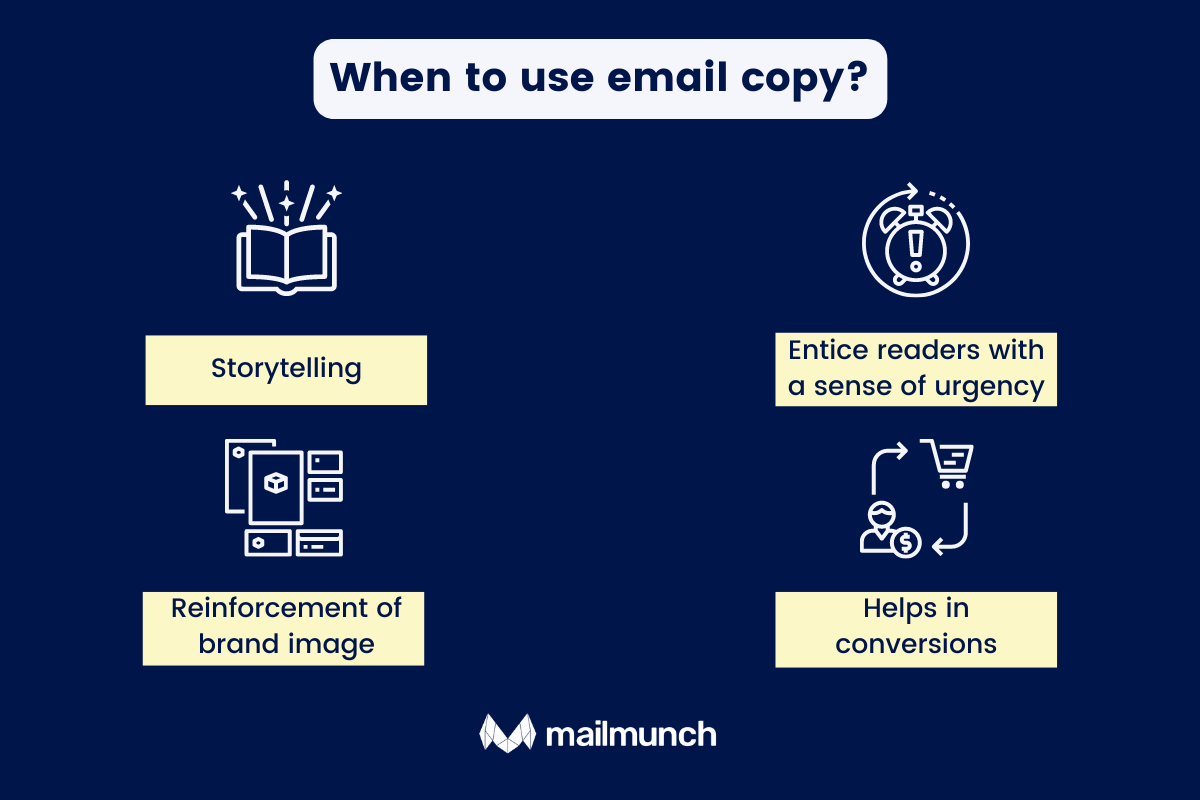
One way to make email copy more persuasive is to tell a story. Stories are a powerful way to connect with readers and persuade them to take action. When writing a story, it is important to focus on the problem that the protagonist is facing and how they overcome it. How do you come up with that, and how do you find ways to back it up? These writing strategies and techniques should be able to help you improve the effectiveness of your storytelling.
This will help to engage the readers and provide them with a relatable example of how the product or service can be of benefit to them.
Also, storytelling can be applied to almost all types of emails, whether it be an initial email, a nurturing email, a promotional email, or a transactional email. Use serial storytelling to your advantage; send emails weekly or monthly to contain a part of the story. This way, you can captivate your prospect and have them anticipate the next part of your story.
Stories can be theme-based. If you are running an email campaign for Halloween, create a story about how your products or services made life easier for your protagonist on Halloween.
FOMO is a potent motivator for people to take action. Veteran email marketers create a sense of urgency in their emails to entice the recipients.
Offering a limited-time discount or voucher that highlights the benefits of taking action now. But you have to write the email content very precisely. Use words like “x% discount” and “for a limited time only” to create that sense of urgency.
A person wants to buy a pair of sneakers for their nephew as a Christmas gift. As a sneaker brand, a timely email from you that highlights the features of your new sneaker can get them interested. Moreover, if you throw in a discount for a limited time, you can successfully create a sense of urgency and thus, can expect a purchase.
But stay true to what you have to offer. Don’t exaggerate your product or service more than what it really is. Make use of testimonials to bolster your claims. Also, you can send out reminders for the limited-time offer.
Email copy can also help to reinforce a brand’s image. This can be done by using language that is in line with the brand’s voice and by highlighting the company’s values. This will help to create a consistent message across all channels and touchpoints.
Email copy can also help to increase conversion rates. Including a strong call-to-action (CTA), such as “Buy Now” or “Sign Up Today” alone can give the much-needed boost for CTRs. The CTA should be clear and concise, and it should be placed in a prominent location within the email, like at the top of the email or in the email footer.
Make sure that the banner or HTML button you use is visible. Use colors that are consistent with your brand's identity.
Email copy is usable in various situations, such as when launching a new product, promoting a sale, or sending out a newsletter. It is important to use email copy relevant to the situation and the audience to which it is being sent.
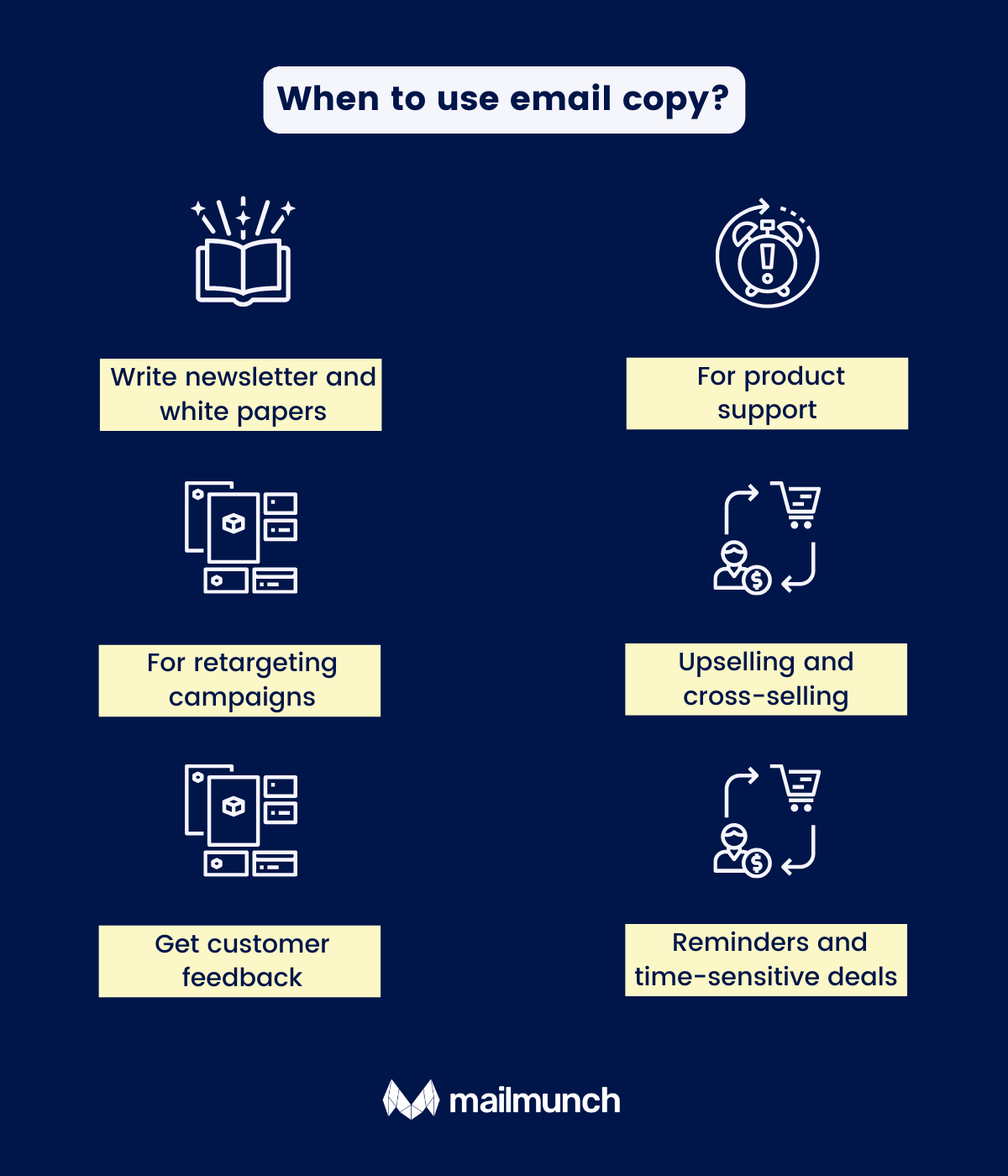
One way to use email copy is to write newsletters and white papers. Providing newsletters or white papers can establish a brand’s authority on the subject.
Not everyone subscribes to an email list to become a buyer. They might subscribe to an email list for information on a subject or a product. Therefore, when writing a newsletter email, the intent should be to provide information instead of converting the prospect into a buyer and also for growing the email list.
But there is a distinction between newsletters and white papers. Newsletters are used for announcing important information. While white papers are authoritative texts written by experts to guide and educate recipients about a particular topic
When writing newsletters and white papers, it is important to focus on quality over quantity. This means that the content should be well-written and informative but shouldn’t be full of jargon.
Design District’s weekly newsletter is an excellent example of how a newsletter should be written.

Another way to use email copy is for product support. This can be done by providing FAQs, troubleshooting tips, and customer testimonials. Product support emails that should be clear and concise and provide only the necessary information to the reader they need in order to resolve the issue.
Email copy can also be used for retargeting campaigns. This involves sending emails to people who have already shown an interest in the product or service but haven't converted yet.
Also, people who want to unsubscribe from an email list can also become the target of a retargeting campaign. Retargeting emails should be personalized to a specific recipient. Don’t use the email blast strategy and send one broadcast email to the entire email list.
Make sure that your copy for retargeting emails is personalized according to the recipients like including the name of the recipient, including important reminders, and providing incentives for signing up again.
Email copy can be an excellent way to upsell and cross sell products and services. This involves promoting other products or services that may interest the customer, but it's important to make sure they're relevant to the customers.
For up selling products, write an email copy that includes things that people have frequently bought together and add links to those products in the email as well.
For cross selling, the email copy should include products and services that aren't bought together frequently but might interest the customers.
For example, Mixcloud, an online music streaming service, is offering recipients, a pro plan subscription, to upgrade to its newest HQ audio feature.
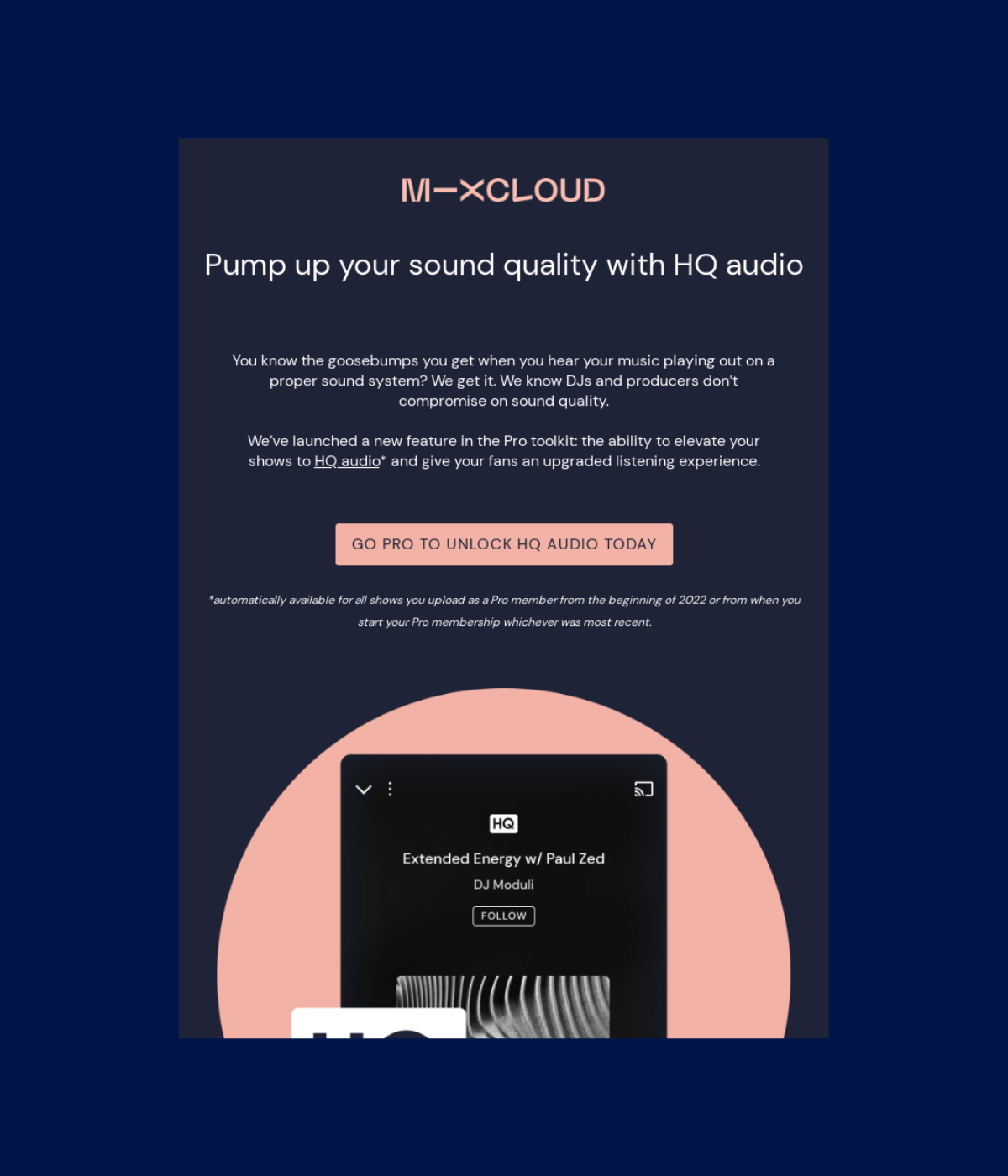
Email copy can also be used to get customer feedback. This can be done by sending out surveys or asking for reviews. Customer feedback helps companies to improve their products and services, so it is important to make sure that the email copy is clear and concise.
Everlane, an apparel store, is asking its customers to leave feedback on its new products.

Email copy can also be used for reminders and time-sensitive deals. Send out an email that reminds the reader of an upcoming deadline or by highlighting a special offer that is only available for a limited time. Reminders and time-sensitive deals help to create a sense of urgency, which can be a powerful motivator for people to take action. eCommerce stores can use reminder emails to their advantage and remind dormant customers to complete their purchases.
Venmo is reminding its customers to update their information by February 6th to continue using its services.
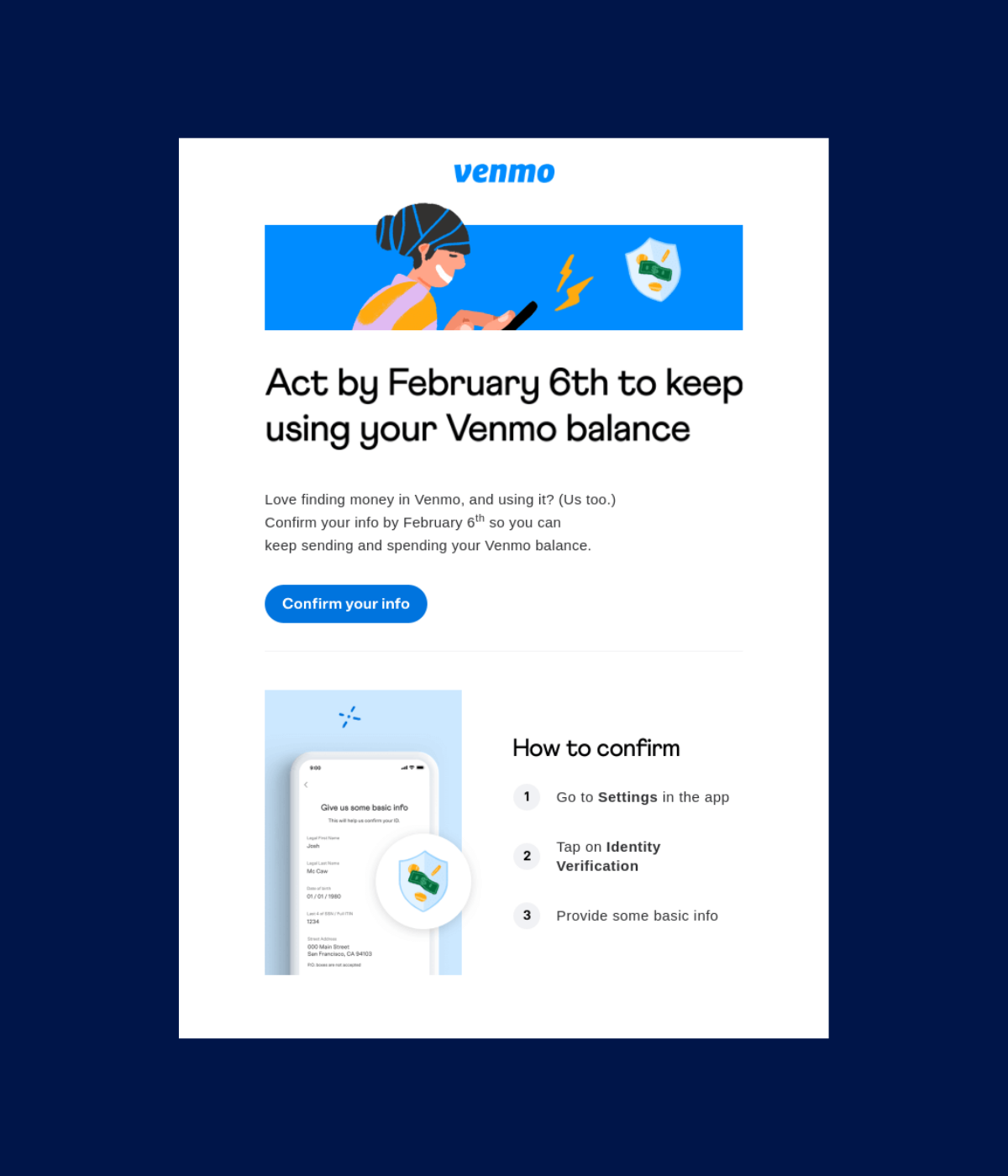
It's important to make sure that the copy in the email body aligns with the subject line. This means that the email should start with a brief introduction that summarizes the main points of the email. The email body should then expand on these points and provide more detailed information.
By doing this, you'll be able to engage your readers and keep their attention focused on the email content. In addition, you'll be able to more effectively communicate your message and ensure that your readers understand what you're trying to say.
The footer of an email is the last thing that the reader will see, so it's important to make sure that it is well-written and informative. The footer should include the company's contact information, unsubscribe option, manage preferences section, and as well as a call to action button.
The copy in the footer should be clear and concise, and it should be free of grammar and spelling errors. Additionally, the footer is designed in a way that makes it easy for the reader to understand and find the information that they're looking for. Keep the footer consistent with the color palette of your emails. Don’t make it hard for your readers to read the footer.
For example, PandaDoc, a SaaS company, has included a CTA, unsubscribe link, manage preferences, and the company address in its email’s footer.
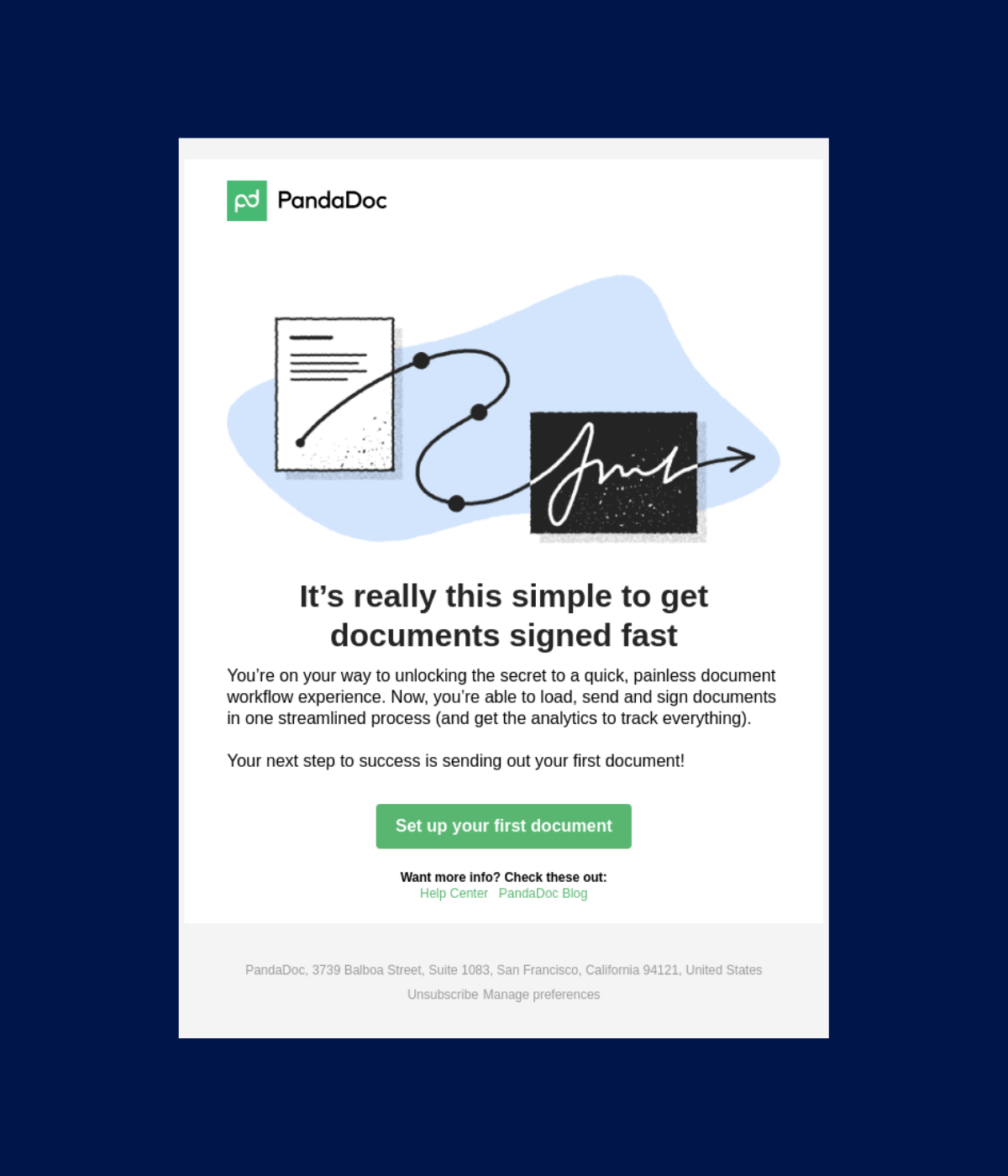
It's important to know who the audience is before writing the email copy. This means researching the target market and segmenting the email list accordingly. By doing this, you'll be able to write email copy that is relevant to your readers and more likely to engage them.
Personalizing the copy is a great way to engage your readers and make them feel special. An employee receives on average 121 emails per day. Therefore, it is important to stand out in a crowded inbox.
There are a few different ways that you can personalize email copy, such as using the recipient's name, or the recipient's company name. Moreover, you can offer them deals and discounts on their favorite products to entice them.
Moreover, personalized email copies generate 5.7x more revenue than emails that aren’t personalized.
For example, Mention, an analytics and social media management company, personalized its email by adding the recipient's name and reminding them that his pro plan will end in 7 days. Moreover, it also highlights the benefits of its pro plan.
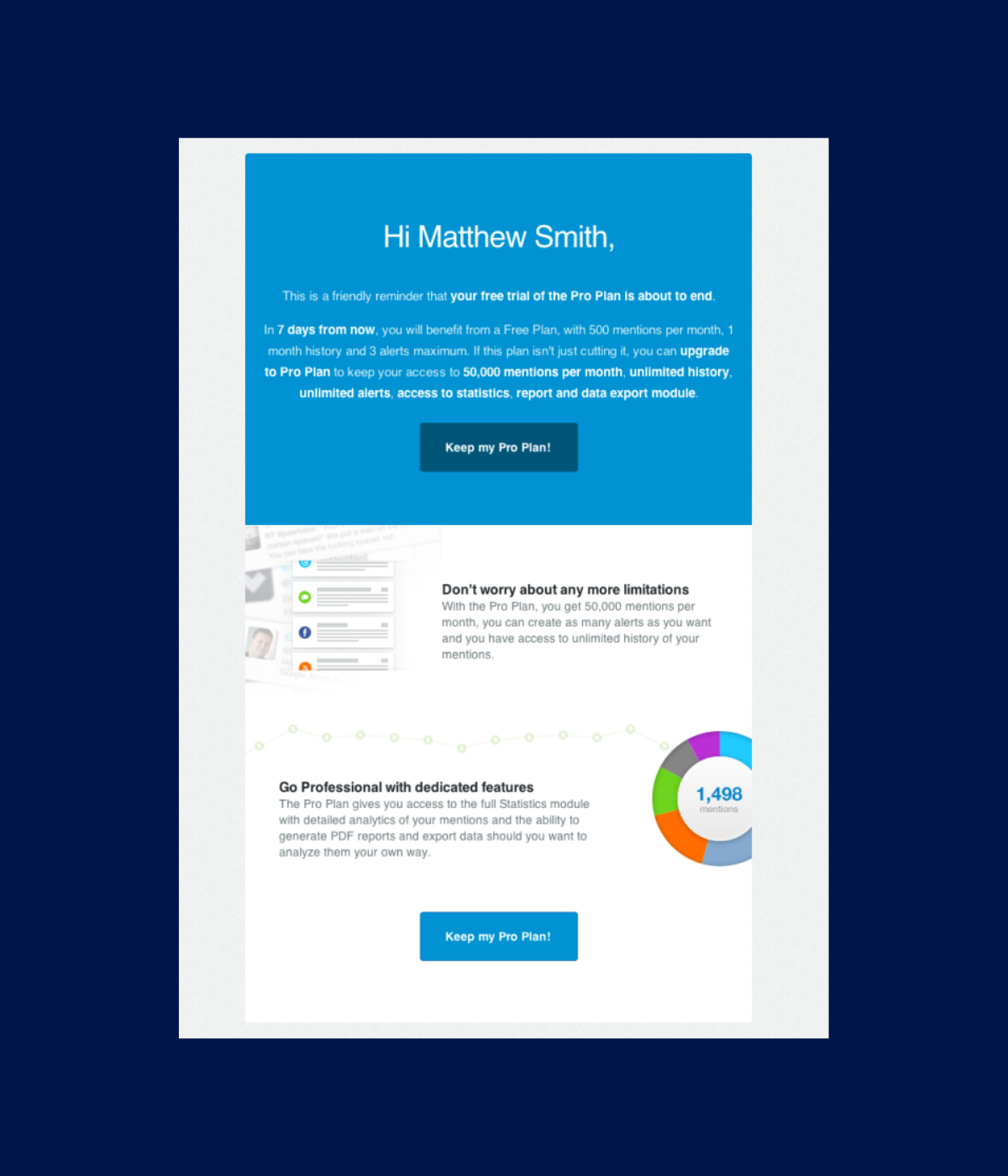
Using fewer words is a great way to make email copy more concise. It's important to remember that people are often busy, so they don't have time to read long emails. By using fewer words, you'll be able to get your point across more quickly and effectively.
However, in the case of a welcome email, sending a long email that highlights your brand's value, products, and services so that the recipient understands your brand better is the ideal approach. Or you can send a series of welcome emails and divide the content that way.
Images are a great way to add visual interest to an email. However, it's important to use optimized images that are the correct size and file type. By doing this, you'll be able to ensure that images load quickly and don't cause any problems for the reader.
Although JPEG is the image format of preference for most marketers, the PNG format offers better colors, and less image quality is lost when exporting the image.
PLAE, a shoe manufacturer, uses high-quality PNG images in its emails to showcase its summer collection.

It It is important to have a clear call-to-action (CTA) when writing emails. The CTA should be concise and easy for your customer or recipient of the email content to see.
Additionally, make sure that you place the CTA where it is most visible, like at the top, center, or footer of the email. Lastly, relate your CTA with your content. If your content is about a new blog post, the CTA should be something like, “Know more” or “Check out our blog.”
For example, Airbnb is telling its customer what smart pricing is and how it can vary depending on the demand for a lodging.
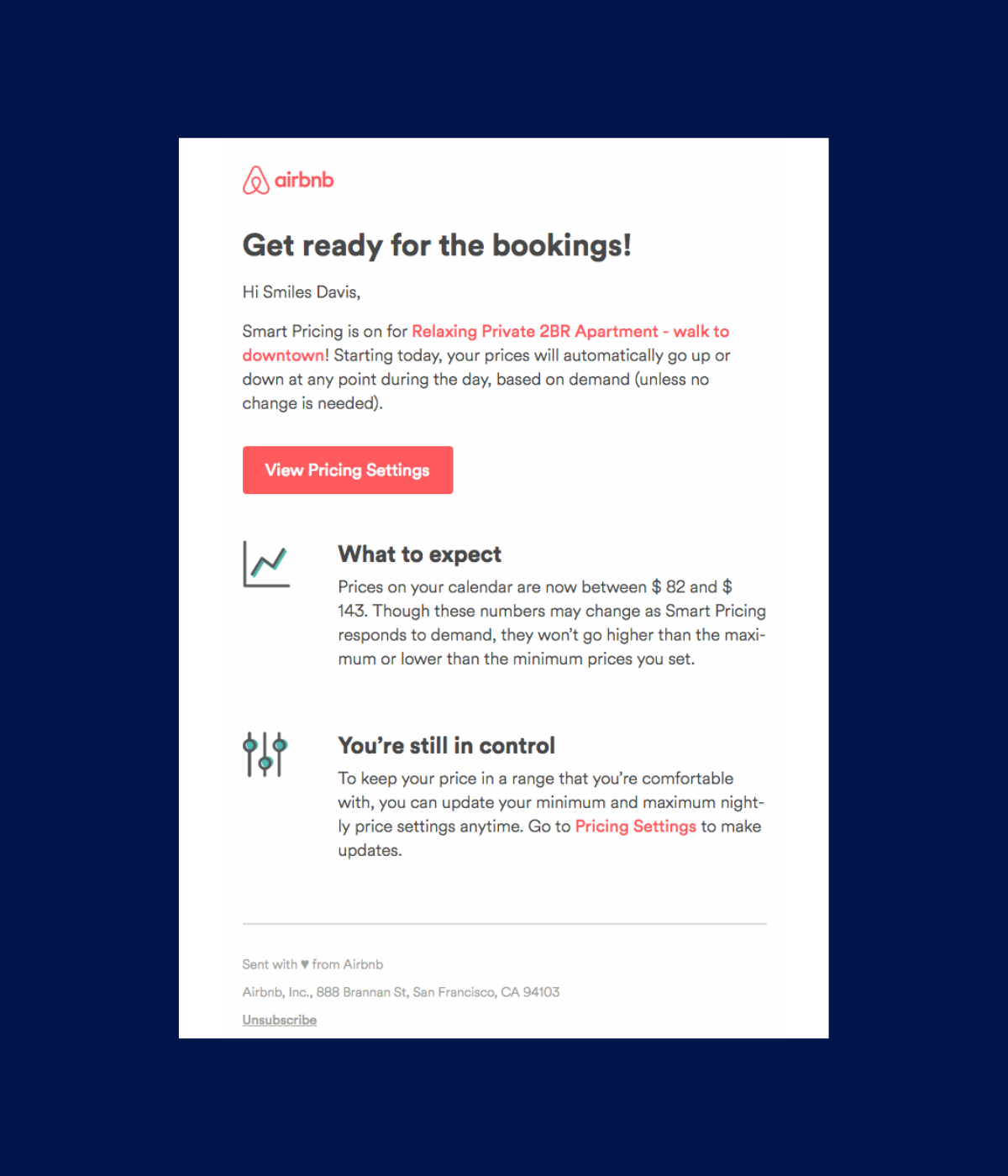
Adding social proof is another way to make the email copy enticing. Numbers are more interesting than just text, so try adding them to see how it impacts readership rates!
You can add customer testimonials. Also, you can add the number of items delivered in a year or talk about awards that your product won.
For example, Mockingbird, a toddler stroller company, includes reviews of its strollers in its emails.
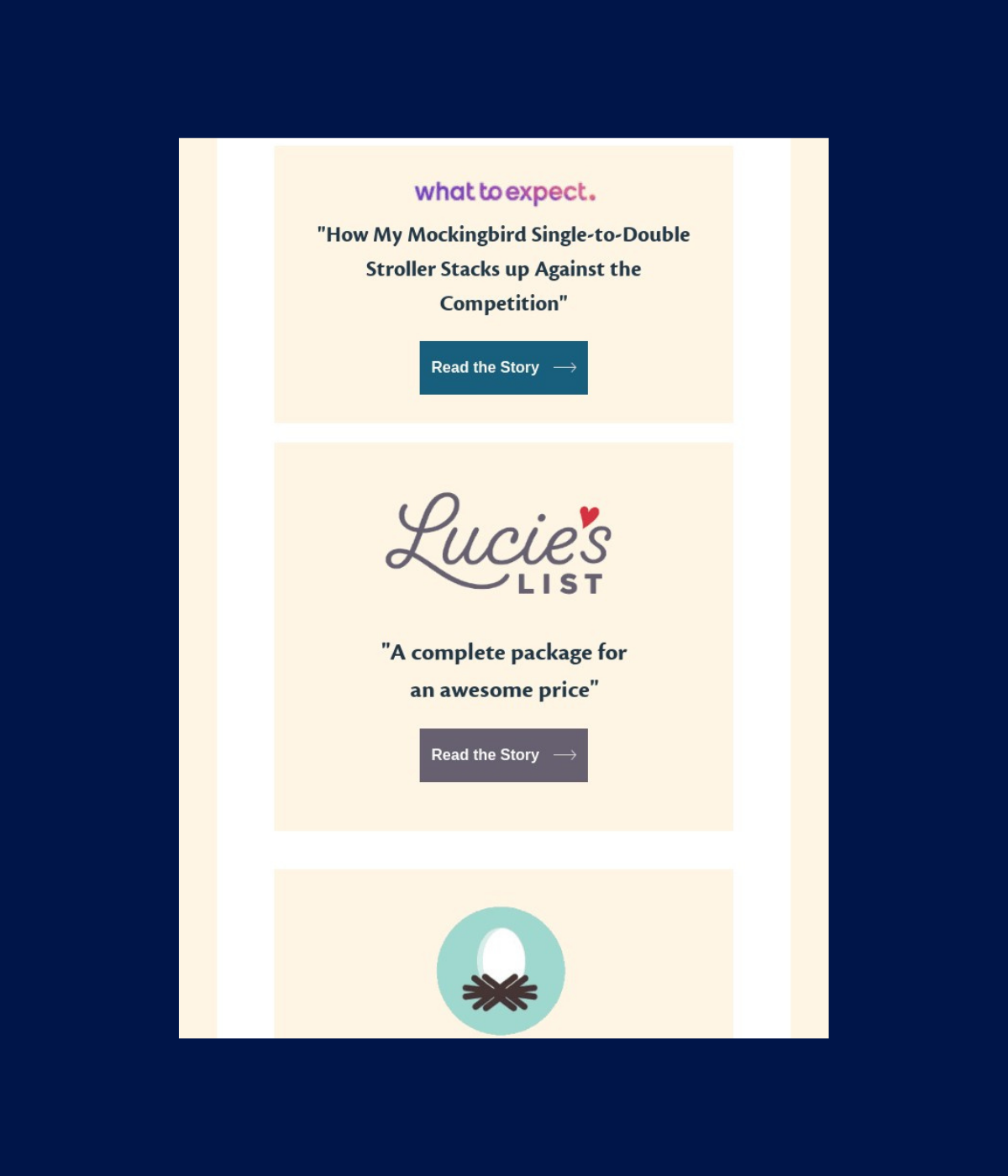
When writing email copy, it's important to stick to one topic. This will help to ensure that your readers stay engaged and don't get overwhelmed by too much information.
If you need to include multiple topics in an email, consider sending a series of emails.
For example, Moment, a platform for photographers and filmmakers, is tells its recipients about the platforms for the best music for their films and videos.
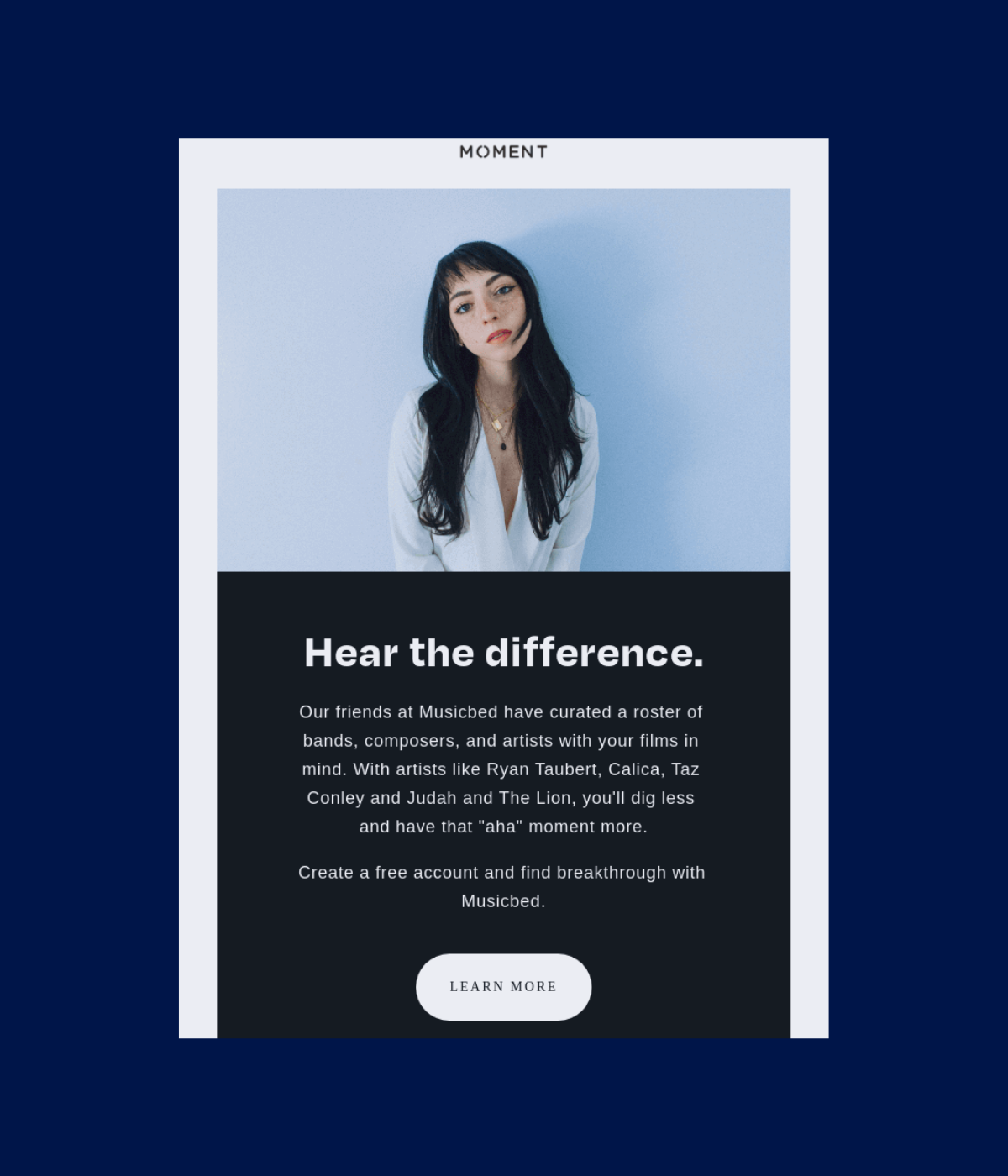
When writing email copy, it's important to avoid triggering the spam filters. There are a few things that you can do to avoid this, such as avoiding using all caps or excessive exclamation points.
Additionally, you should make sure that the email copy is relevant to your topic and doesn't include any false claims. Add disclaimers in the email footers about the services you don’t provide. This will tell the spam filter that you're a genuine business. Thus, allowing your emails to be placed in the recipients’ inboxes and improving email deliverability.
It may seem like a lot of work, but the benefits are worth it. Your message will be easy for recipients to understand without being too complicated or jargon-filled; plus you'll build trust with your customers by using simple language that they can easily digest! When crafting new emails make sure to avoid big words/jargon.
But if you are writing a technical email copy, then do include jargon and, if possible, explain them as well. If you are not able to prevent the use of jargon, then consider rewording the email.
Before you send out any email, it's important to proofread your copy. This will help to ensure that there are no grammatical errors or typos. You can also get your email copy proofread by a senior colleague or a professional proofreader.
When writing email copy, it's important to adopt a conversational tone. This will help your readers feel like they're having a conversation with you rather than being lectured to.
Ask questions from the recipients about your product or service, and then answer the questions. Also, highlight the important points of your answers. This way, the recipients who don’t have the time to read the entire email will get its gist even if they skim through it.
When writing email copy, it's important to highlight the benefits of your product or service. This will help to convince your readers that they need what you're offering.
To do this, focus on the customer's needs and don’t use language that indicates that you're forcing your product or service on them. Include testimonials to showcase how your product or service helped others.
Before you send out your email, it's important to test it. This will help to ensure that everything looks the way you want it to and that there are no technical issues. Additionally, testing will help you to catch any typos or grammatical errors. Moreover, testing the emails can also reveal whether or not there is an issue with the tone or language of the email copy.
A/B testing the emails can help you understand what kind of emails the recipients are interested in seeing.
As email copies are the cornerstone of any email marketing campaign, they should be written with utmost care and attention. A brilliant email copy needs a complementing template. So, Mailmunch is here to offer you some brilliant email templates.
An email copywriter is a person that writes persuasive marketing emails for recipients to take action on the email copy. They have a wide range of vocabulary and are also good at research.
Personalizing the emails is the best way to improve abandoned cart rates. Use the name of the recipient in the email and highlight the abandoned products in the cart as well. Include a clear CTA to encourage the customer to complete the purchase.
Shorter emails are likely to get more engagement like a link click. But if you have to send a long email, then divide the email into a series of emails.
Create two versions of an email with some variations like changing the placement of the CTA button or using a conversational tone in one email and a descriptive tone in the other. Then send both of these emails to two different groups and see which one performs better.
A voracious reader and a music lover, Ammar has been writing engaging and informative content for over 3 years for B2B and B2C markets. With a knack for writing SEO-optimized content, Ammar ensures the results speak for themselves.
Tags:

M. Usama
April 19, 2024

M. Usama
April 19, 2024

M. Usama
April 18, 2024